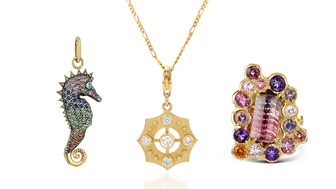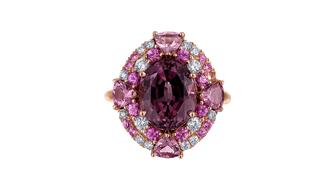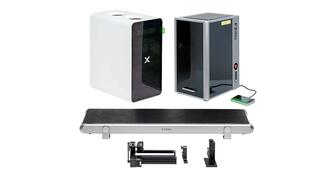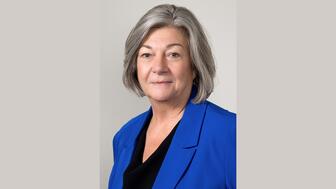As the shopping mall model evolves and online retail grows, Smith shares his predictions for the future of physical stores.
Gübelin’s Blockchain for Gems Now Open to the Industry
The Swiss gem lab’s Provenance Proof technology debuted during AGTA GemFair.

The Swiss gem lab launched its Provenance Proof Blockchain during AGTA GemFair, officially opening its use to the trade.
Now, any professional stakeholder along the supply chain can register and, after a standard “Know your Customer” check, start using it.
It’s been a little more than a year since Gübelin announced it was developing the program to trace colored gemstones from mine to market, which it calls the first of its kind in the world.
The project comes as part of the lab’s Provenance Proof initiative, a long-term program designed to develop and provide technologies to the gemstone industry to make it more transparent. It includes the lab’s “Emerald Paternity Test.”
Gübelin’s blockchain aims to track a stone as early in the supply chain as possible to build a record of each rough gemstone’s journey. The owner or custodian of the stone is then able to contribute certain information to the log book through to, and including, the end consumer.
Fura Gems was the mining pilot partner, offering goods at its Coscuez Colombian emerald mine as test subjects for the blockchain technology.
The Gübelin family shouldered the cost of developing the technology, which means it is free to use for anyone in the trade.
“The industry has been changing and consumers are now interested in transparency, and this was my main motivation … to support blockchain and this whole initiative because I think we need to change now,” Raphael Gübelin, president of the House of Gübelin, said in Tucson.
To help keep it inclusive, every process, including the registration and upload of the data, can be done on a smartphone.
Visibility is restricted to the user in custody of the gemstone, and only is allowed upstream—meaning the current users can see who had the gemstone before them but do not see where it goes once it leaves their possession—though Everledger CEO Leanne Kemp told National Jeweler during an interview after the launch event that it could be reversed to allow someone at the beginning of the chain to see subsequent actions should users give permission to do so.
Gübelin Gem Lab Managing Director Daniel Nyfeler also noted that the lab has no privileged insight into specific data of the blockchain; the lab itself can only see the information entered into the blockchain relating to the stones it is entrusted with testing.
WATCH: Gübelin Explains How the Blockchain Works
He said it also makes economic sense to embrace it; blockchain could offer greater visibility for companies along the supply chain and offer retailers the full information to build the story behind a stone.
Nyfeler, along with Kemp, Raphael Gübelin, Fura Gems Vice President Marketing and Sales Rupak Sen, and Pat Syvrud, minerals, materials and society program development manager at the University of Delaware, took part in a panel after presentations during the Tucson launch.
During the panel, Nyfeler addressed one of the biggest criticisms of blockchain—it does not have the ability to prevent a user from entering false data that then appears legitimate as it is locked into the blockchain.
“Blockchain is not the silver bullet that’s going to bring 100 percent trueness in the industry immediately, but … it’s going to be much easier to determine over time and see patterns, and you’re going to see where such wrong information might come from, which so far is not the case and that’s the point where we were starting from,” he said.
When an attendee also asked whether the small-scale miners would care about becoming a part of this, Nyfeler said it was up to the industry to encourage them to do so.
Looking to the future, he told National Jeweler that Provenance Proof, like De Beers’ Tracr, is a long-term venture that eventually will be spun off as its own company.
A supervisory board will be entrusted with making strategic decisions, such as data security and compliance issues, and will consist mostly of individuals independent of the gemstone industry “in order to minimize the risk of conflicting interests.”
And since certain segments of stakeholders will have specific needs related to the use of the blockchain, such as a large-scale miner or wholesaler wanting interfaces to allow for the automated upload or exchange of the company’s inventory system, Provenance Proof—not Gübelin Gem Lab—will oversee designing, building and implementing solutions to address these needs.
The Latest

The trade show is slated for Jan. 31-Feb. 2 at The Lighthouse in New York City's Chelsea neighborhood.

January’s birthstone comes in a rainbow of colors, from the traditional red to orange, purple, and green.

How Jewelers of America’s 20 Under 40 are leading to ensure a brighter future for the jewelry industry.

Footage of a fight breaking out in the NYC Diamond District was viewed millions of times on Instagram and Facebook.


The supplier has a curated list of must-have tools for jewelers doing in-house custom work this year.

The Signet Jewelers-owned store, which turned 100 last year, calls its new concept stores “The Edit.”

Roseco’s 704-page catalog showcases new lab-grown diamonds, findings, tools & more—available in print or interactive digital editions.

Linda Coutu is rejoining the precious metals provider as its director of sales.

Sparkle with festive diamond jewelry as we celebrate the beginning of 2026.

The master jeweler, Olympian, former senator, and Korean War veteran founded the brand Nighthorse Jewelry.

In its annual report, Pinterest noted an increase in searches for brooches, heirloom jewelry, and ‘80s luxury.

Executive Chairman Richard Baker will take over the role as rumors swirl that a bankruptcy filing is imminent for the troubled retailer.

Mohr had just retired in June after more than two decades as Couture’s retailer liaison.

Shekhar Shah of Real Gems Inc. will serve as president of the Indian Diamond & Colorstone Association in 2026.

This year’s good luck charm features the mythical horse Pegasus, and is our first Piece of the Week of the new year.

Articles about crime, engagement rings, and a necklace worn in the World Series generated the most interest among readers.

As part of the leadership transition, Sherry Smith will take on the role of vice president of coaching strategy and development.

It marks the third time the country has headed the Kimberley Process. Ghana will serve as vice chair.

The new Bulova x Stetson designs highlight two animals often associated with the American West—the bison and the Texas Longhorn.

Its residency at Yamron Jewelers will run through May 2026.

From influential executives to innovative designers, we pay tribute to the people we said goodbye to this year.

The retailer is expanding into areas with large Indian and South Asian populations.

The Italian brand has opened its first flagship amid the peaks of the Dolomites in Madonna di Campiglio, Italy.

The new curation at the Natural History Museum of Los Angeles County showcases rare gem and mineral specimens in their uncut, natural state.

The couple pleaded guilty to concealing at least $127 million in cash transactions at its precious metals businesses.

Consumers shared concerns about prices, inflation, tariffs, trade, and politics in the survey’s write-in response section.




























